
vim-ai
AI-powered code assistant for Vim. OpenAI and ChatGPT plugin for Vim and Neovim.
Stars: 878
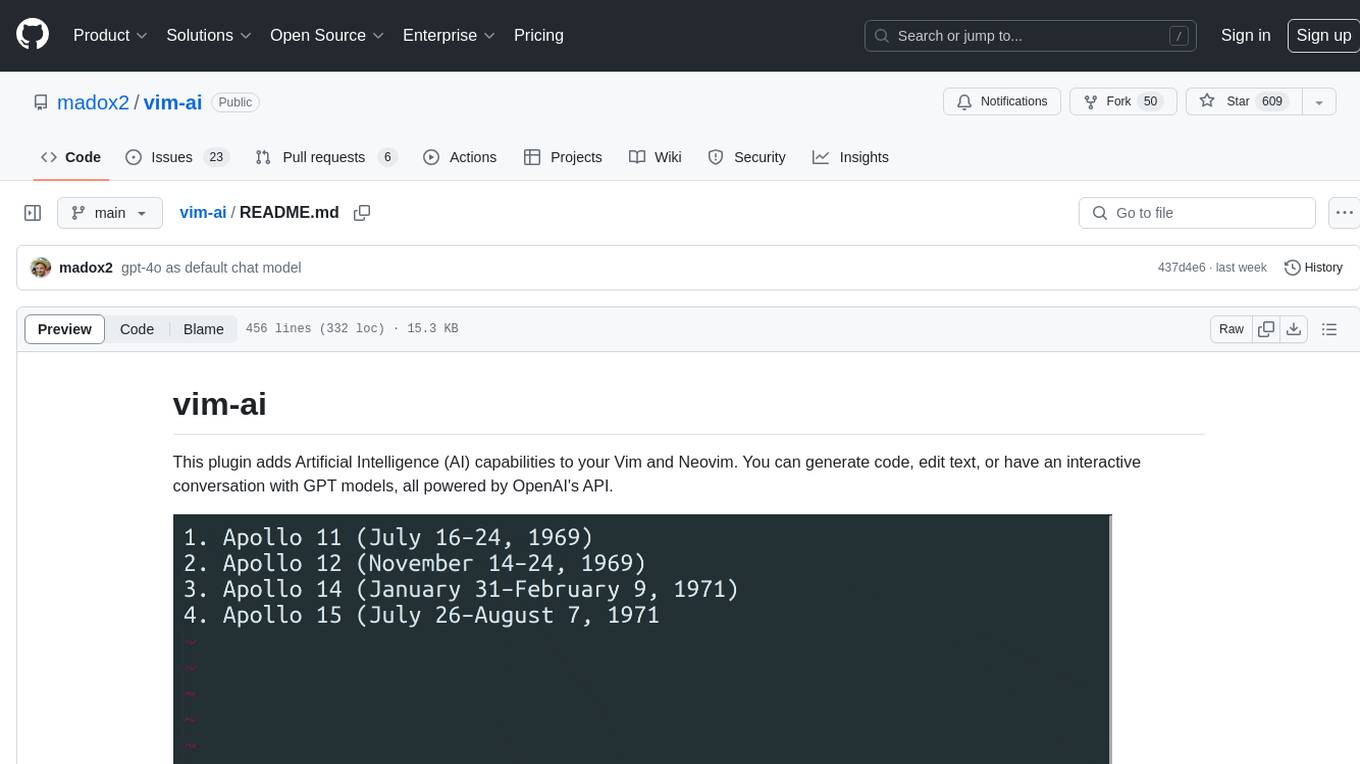
vim-ai is a plugin that adds Artificial Intelligence (AI) capabilities to Vim and Neovim. It allows users to generate code, edit text, and have interactive conversations with GPT models powered by OpenAI's API. The plugin uses OpenAI's API to generate responses, requiring users to set up an account and obtain an API key. It supports various commands for text generation, editing, and chat interactions, providing a seamless integration of AI features into the Vim text editor environment.
README:
This plugin adds Artificial Intelligence (AI) capabilities to your Vim and Neovim. You can generate code, edit text, or have an interactive conversation with GPT models, all powered by OpenAI's API.
To get an idea what is possible to do with AI commands see the prompts on the Community Wiki
- Generate text or code, answer questions with AI
- Edit selected text in-place with AI
- Interactive conversation with ChatGPT
- Custom roles
- Vision capabilities (image to text)
- Generate images
- Integrates with any OpenAI-compatible API
- AI provider plugins
This plugin uses OpenAI's API to generate responses. You will need to setup an account and obtain an API key. Usage of the API is not free, but the cost is reasonable and depends on how many tokens you use, in simple terms, how much text you send and receive (see pricing). Note that the plugin does not send any of your code behind the scenes. You only share and pay for what you specifically select, for prompts and chat content.
In case you would like to experiment with Gemini, Claude or other models running as a service or locally, you can use any OpenAI compatible proxy. A simple way is to use OpenRouter which has a fair pricing (and currently offers many models for free), or setup a proxy like LiteLLM locally. See this simple guide on configuring custom OpenRouter roles.
🚨 Announcement 🚨
vim-ai can now be extended with custom provider plugins.
However, there aren't many available yet, so developing new ones is welcome!
For more, see the providers section.
- Vim or Neovim compiled with python3 support
- API key
# save api key to `~/.config/openai.token` file
echo "YOUR_OPENAI_API_KEY" > ~/.config/openai.token
# alternatively set it as an environment variable
export OPENAI_API_KEY="YOUR_OPENAI_API_KEY"
# or configure it with your organization id
echo "YOUR_OPENAI_API_KEY,YOUR_OPENAI_ORG_ID" > ~/.config/openai.token
export OPENAI_API_KEY="YOUR_OPENAI_API_KEY,YOUR_OPENAI_ORG_ID"The default api key file location is ~/.config/openai.token, but you can change it by setting the g:vim_ai_token_file_path in your .vimrc file:
let g:vim_ai_token_file_path = '~/.config/openai.token'Plug 'madox2/vim-ai'Using built-in Vim packages :help packages
# vim
mkdir -p ~/.vim/pack/plugins/start
git clone https://github.com/madox2/vim-ai.git ~/.vim/pack/plugins/start/vim-ai
# neovim
mkdir -p ~/.local/share/nvim/site/pack/plugins/start
git clone https://github.com/madox2/vim-ai.git ~/.local/share/nvim/site/pack/plugins/start/vim-aiTo use an AI command, type the command followed by an instruction prompt. You can also combine it with a visual selection. Here is a brief overview of available commands:
========== Basic AI commands ==========
:AI complete text
:AIEdit edit text
:AIChat continue or open new chat
:AIImage generate image
============== Utilities ==============
:AIRedo repeat last AI command
:AIUtilRolesOpen open role config file
:AIUtilDebugOn turn on debug logging
:AIUtilDebugOff turn off debug logging
:help vim-ai
Tip: Press Ctrl-c anytime to cancel completion
Tip: Use command shortcuts - :AIE, :AIC, :AIR, :AII or setup your own key bindings
Tip: Define and use custom roles, e.g. :AIEdit /grammar.
Tip: Use pre-defined roles /right, /below, /tab to choose how chat is open, e.g. :AIC /right
Tip: Use special role /populate to dump options to chat header, e.g. :AIC /populate /gemini
Tip: Combine commands with a range :help range, e.g. to select the whole buffer - :%AIE fix grammar
If you are interested in more tips or would like to level up your Vim with more commands like :GitCommitMessage - suggesting a git commit message, visit the Community Wiki.
This is the list of 3rd party provider plugins allowing to use different AI providers.
- google provider - Google's Gemini models
In case you are interested in developing one, have a look at reference google provider. Do not forget to open PR updating this list.
In the context of this plugin, a role means a re-usable AI instruction and/or configuration. Roles are defined in the configuration .ini file. For example by defining a grammar and o1-mini role:
let g:vim_ai_roles_config_file = '/path/to/my/roles.ini'# /path/to/my/roles.ini
[grammar]
prompt = fix spelling and grammar
options.temperature = 0.4
[o1-mini]
options.stream = 0
options.model = o1-mini
options.max_completion_tokens = 25000
options.temperature = 1
options.initial_prompt =Now you can select text and run it with command :AIEdit /grammar.
You can also combine roles :AI /o1-mini /grammar helo world!
See roles-example.ini for more examples.
In the documentation below, <selection> denotes a visual selection or any other range, {instruction} an instruction prompt, {role} a custom role and ? symbol an optional parameter.
:AI {prompt} - complete the prompt
<selection> :AI - complete the selection
<selection> :AI {instruction} - complete the selection using the instruction
<selection>? :AI /{role} {instruction}? - use role to complete
<selection>? :AIEdit - edit the current line or the selection
<selection>? :AIEdit {instruction} - edit the current line or the selection using the instruction
<selection>? :AIEdit /{role} {instruction}? - use role to edit
:AIImage {prompt} - generate image with prompt
<selection> :AIImage - generate image with seleciton
<selection>? :AI /{role} {instruction}? - use role to generate
Pre-defined image roles: /hd, /natural
:AIChat - continue or start a new conversation.
<selection>? :AIChat {instruction}? - start a new conversation given the selection, the instruction or both
<selection>? :AIChat /{role} {instruction}? - use role to complete
When the AI finishes answering, you can continue the conversation by entering insert mode, adding your prompt, and then using the command :AIChat once again.
Pre-defined chat roles: /right, /below, /tab
You can edit and save the chat conversation to an .aichat file and restore it later.
This allows you to create re-usable custom prompts, for example:
# ./refactoring-prompt.aichat
>>> system
You are a Clean Code expert, I have the following code, please refactor it in a more clean and concise way so that my colleagues can maintain the code more easily. Also, explain why you want to refactor the code so that I can add the explanation to the Pull Request.
>>> user
[attach code]
To include files in the chat a special include section is used:
>>> user
Generate documentation for the following files
>>> include
/home/user/myproject/requirements.txt
/home/user/myproject/**/*.py
Each file's contents will be added to an additional user message with ==> {path} <== header, relative paths are resolved to the current working directory.
To use image vision capabilities (image to text) include an image file:
>>> user
What object is on the image?
>>> include
~/myimage.jpg
Execute command and include stdout into the chat:
>>> user
Suggest git commit message
>>> exec
git diff
Supported chat sections are >>> system, >>> user, >>> include, >>> exec and <<< assistant
:AIRedo - repeat last AI command
Use this immediately after AI/AIEdit/AIChat command in order to re-try or get an alternative completion.
Note that the randomness of responses heavily depends on the temperature parameter.
Each command is configured with a corresponding configuration variable.
To customize the default configuration, initialize the config variable with a selection of options, for example put this to your.vimrc file:
let g:vim_ai_chat = {
\ "options": {
\ "model": "o1-preview",
\ "stream": 0,
\ "temperature": 1,
\ "max_completion_tokens": 25000,
\ "initial_prompt": "",
\ },
\}Alternatively you can use special default role:
[default.chat]
options.model = o1-preview
options.stream = 0
options.temperature = 1
options.max_completion_tokens = 25000
options.initial_prompt =Or customize the options directly in the chat buffer:
[chat]
options.model = o1-preview
options.stream = 0
options.temperature = 1
options.max_completion_tokens = 25000
options.initial_prompt =
>>> user
generate a paragraph of lorem ipsumBelow are listed all available configuration options, along with their default values. Please note that there isn't any token limit imposed on chat model.
" This prompt instructs model to be consise in order to be used inline in editor
let s:initial_complete_prompt =<< trim END
>>> system
You are a general assistant.
Answer shortly, consisely and only what you are asked.
Do not provide any explanantion or comments if not requested.
If you answer in a code, do not wrap it in markdown code block.
END
" :AI
" - provider: AI provider
" - prompt: optional prepended prompt
" - options: openai config (see https://platform.openai.com/docs/api-reference/completions)
" - options.initial_prompt: prompt prepended to every chat request (list of lines or string)
" - options.temperature: use -1 to disable this parameter
" - options.request_timeout: request timeout in seconds
" - options.auth_type: API authentication method (bearer, api-key, none)
" - options.token_file_path: override global token configuration
" - options.token_load_fn: expression/vim function to load token
" - options.selection_boundary: selection prompt wrapper (eliminates empty responses, see #20)
" - ui.paste_mode: use paste mode (see more info in the Notes below)
let g:vim_ai_complete = {
\ "provider": "openai",
\ "prompt": "",
\ "options": {
\ "model": "gpt-4o",
\ "endpoint_url": "https://api.openai.com/v1/chat/completions",
\ "max_tokens": 0,
\ "max_completion_tokens": 0,
\ "temperature": 0.1,
\ "request_timeout": 20,
\ "stream": 1,
\ "auth_type": "bearer",
\ "token_file_path": "",
\ "token_load_fn": "",
\ "selection_boundary": "#####",
\ "initial_prompt": s:initial_complete_prompt,
\ },
\ "ui": {
\ "paste_mode": 1,
\ },
\}
" :AIEdit
" - provider: AI provider
" - prompt: optional prepended prompt
" - options: openai config (see https://platform.openai.com/docs/api-reference/completions)
" - options.initial_prompt: prompt prepended to every chat request (list of lines or string)
" - options.temperature: use -1 to disable this parameter
" - options.request_timeout: request timeout in seconds
" - options.auth_type: API authentication method (bearer, api-key, none)
" - options.token_file_path: override global token configuration
" - options.token_load_fn: expression/vim function to load token
" - options.selection_boundary: selection prompt wrapper (eliminates empty responses, see #20)
" - ui.paste_mode: use paste mode (see more info in the Notes below)
let g:vim_ai_edit = {
\ "provider": "openai",
\ "prompt": "",
\ "options": {
\ "model": "gpt-4o",
\ "endpoint_url": "https://api.openai.com/v1/chat/completions",
\ "max_tokens": 0,
\ "max_completion_tokens": 0,
\ "temperature": 0.1,
\ "request_timeout": 20,
\ "stream": 1,
\ "auth_type": "bearer",
\ "token_file_path": "",
\ "token_load_fn": "",
\ "selection_boundary": "#####",
\ "initial_prompt": s:initial_complete_prompt,
\ },
\ "ui": {
\ "paste_mode": 1,
\ },
\}
" This prompt instructs model to work with syntax highlighting
let s:initial_chat_prompt =<< trim END
>>> system
You are a general assistant.
If you attach a code block add syntax type after ``` to enable syntax highlighting.
END
" :AIChat
" - provider: AI provider
" - prompt: optional prepended prompt
" - options: openai config (see https://platform.openai.com/docs/api-reference/chat)
" - options.initial_prompt: prompt prepended to every chat request (list of lines or string)
" - options.temperature: use -1 to disable this parameter
" - options.request_timeout: request timeout in seconds
" - options.auth_type: API authentication method (bearer, api-key, none)
" - options.token_file_path: override global token configuration
" - options.token_load_fn: expression/vim function to load token
" - options.selection_boundary: selection prompt wrapper (eliminates empty responses, see #20)
" - ui.open_chat_command: preset (preset_below, preset_tab, preset_right) or a custom command
" - ui.populate_options: dump [chat] config to the chat header
" - ui.scratch_buffer_keep_open: re-use scratch buffer within the vim session
" - ui.force_new_chat: force new chat window (used in chat opening roles e.g. `/tab`)
" - ui.paste_mode: use paste mode (see more info in the Notes below)
let g:vim_ai_chat = {
\ "provider": "openai",
\ "prompt": "",
\ "options": {
\ "model": "gpt-4o",
\ "endpoint_url": "https://api.openai.com/v1/chat/completions",
\ "max_tokens": 0,
\ "max_completion_tokens": 0,
\ "temperature": 1,
\ "request_timeout": 20,
\ "stream": 1,
\ "auth_type": "bearer",
\ "token_file_path": "",
\ "token_load_fn": "",
\ "selection_boundary": "",
\ "initial_prompt": s:initial_chat_prompt,
\ },
\ "ui": {
\ "open_chat_command": "preset_below",
\ "scratch_buffer_keep_open": 0,
\ "populate_options": 0,
\ "force_new_chat": 0,
\ "paste_mode": 1,
\ },
\}
" :AIImage
" - prompt: optional prepended prompt
" - options: openai config (https://platform.openai.com/docs/api-reference/images/create)
" - options.request_timeout: request timeout in seconds
" - options.auth_type: API authentication method (bearer, api-key, none)
" - options.token_file_path: override global token configuration
" - options.token_load_fn: expression/vim function to load token
" - options.download_dir: path to image download directory, `cwd` if not defined
let g:vim_ai_image = {
\ "provider": "openai",
\ "prompt": "",
\ "options": {
\ "model": "dall-e-3",
\ "endpoint_url": "https://api.openai.com/v1/images/generations",
\ "quality": "standard",
\ "size": "1024x1024",
\ "style": "vivid",
\ "request_timeout": 40,
\ "auth_type": "bearer",
\ "token_file_path": "",
\ "token_load_fn": "",
\ },
\ "ui": {
\ "download_dir": "",
\ },
\}
" custom roles file location
let g:vim_ai_roles_config_file = s:plugin_root . "/roles-example.ini"
" custom token file location
let g:vim_ai_token_file_path = "~/.config/openai.token"
" custom fn to load token, e.g. "g:GetAIToken()"
let g:vim_ai_token_load_fn = ""
" enables/disables full markdown highlighting in aichat files
" NOTE: code syntax highlighting works out of the box without this option enabled
" NOTE: highlighting may be corrupted when using together with the `preservim/vim-markdown`
g:vim_ai_chat_markdown = 0
" debug settings
let g:vim_ai_debug = 0
let g:vim_ai_debug_log_file = "/tmp/vim_ai_debug.log"
" Notes:
" ui.paste_mode
" - if disabled code indentation will work but AI doesn't always respond with a code block
" therefore it could be messed up
" - find out more in vim's help `:help paste`
" options.max_tokens
" - note that prompt + max_tokens must be less than model's token limit, see #42, #46
" - setting max tokens to 0 will exclude it from the OpenAI API request parameters, it is
" unclear/undocumented what it exactly does, but it seems to resolve issues when the model
" hits token limit, which respond with `OpenAI: HTTPError 400`
" options.selection_boundary
" - setting ``` value behaves in markdown-like fasion - adds filetype to the boundary
### Using custom API
It is possible to configure the plugin to use different OpenAI-compatible endpoints.
See some cool projects listed in [Custom APIs](https://github.com/madox2/vim-ai/wiki/Custom-APIs) section on the [Community Wiki](https://github.com/madox2/vim-ai/wiki).
```vim
let g:vim_ai_chat = {
\ "options": {
\ "endpoint_url": "http://localhost:8000/v1/chat/completions",
\ "auth_type": "none",
\ },
\}First you need open an account on OpenRouter website and create an api key. You can start with free models and add credits later if you wish. Then you set up a custom role that points to the OpenRouter endpoint:
[gemini]
options.token_file_path = ~/.config/openrouter.token
options.endpoint_url = https://openrouter.ai/api/v1/chat/completions
options.model = google/gemini-exp-1121:free
[llama]
options.token_file_path = ~/.config/openrouter.token
options.endpoint_url = https://openrouter.ai/api/v1/chat/completions
options.model = meta-llama/llama-3.3-70b-instruct
[claude]
options.token_file_path = ~/.config/openrouter.token
options.endpoint_url = https://openrouter.ai/api/v1/chat/completions
options.model = anthropic/claude-3.5-haikuNow you can use the role:
:AI /gemini who created you?
I was created by Google.
This plugin does not set any key binding. Create your own bindings in the .vimrc to trigger AI commands, for example:
" complete text on the current line or in visual selection
nnoremap <leader>a :AI<CR>
xnoremap <leader>a :AI<CR>
" edit text with a custom prompt
xnoremap <leader>s :AIEdit fix grammar and spelling<CR>
nnoremap <leader>s :AIEdit fix grammar and spelling<CR>
" trigger chat
xnoremap <leader>c :AIChat<CR>
nnoremap <leader>c :AIChat<CR>
" redo last AI command
nnoremap <leader>r :AIRedo<CR>You might find useful a collection of custom commands on the Community Wiki.
To create a custom command, you can call AIRun, AIEditRun and AIChatRun functions. For example:
" custom command suggesting git commit message, takes no arguments
function! GitCommitMessageFn()
let l:range = 0
let l:diff = system('git --no-pager diff --staged')
let l:prompt = "generate a short commit message from the diff below:\n" . l:diff
let l:config = {
\ "options": {
\ "model": "gpt-4o",
\ "initial_prompt": ">>> system\nyou are a code assistant",
\ "temperature": 1,
\ },
\}
call vim_ai#AIRun(l:range, l:config, l:prompt)
endfunction
command! GitCommitMessage call GitCommitMessageFn()
" custom command that provides a code review for selected code block
function! CodeReviewFn(range) range
let l:prompt = "programming syntax is " . &filetype . ", review the code below"
let l:config = {
\ "options": {
\ "initial_prompt": ">>> system\nyou are a clean code expert",
\ },
\}
exe a:firstline.",".a:lastline . "call vim_ai#AIChatRun(a:range, l:config, l:prompt)"
endfunction
command! -range -nargs=? AICodeReview <line1>,<line2>call CodeReviewFn(<range>)Contributions are welcome! Please feel free to open a pull request, report an issue, or contribute to the Community Wiki.
Accuracy: GPT is good at producing text and code that looks correct at first glance, but may be completely wrong. Be sure to thoroughly review, read and test all output generated by this plugin!
Privacy: This plugin sends text to OpenAI (or other providers) when generating completions and edits. Therefore, do not use it on files containing sensitive information.
For Tasks:
Click tags to check more tools for each tasksFor Jobs:
Alternative AI tools for vim-ai
Similar Open Source Tools

vim-ai
vim-ai is a plugin that adds Artificial Intelligence (AI) capabilities to Vim and Neovim. It allows users to generate code, edit text, and have interactive conversations with GPT models powered by OpenAI's API. The plugin uses OpenAI's API to generate responses, requiring users to set up an account and obtain an API key. It supports various commands for text generation, editing, and chat interactions, providing a seamless integration of AI features into the Vim text editor environment.
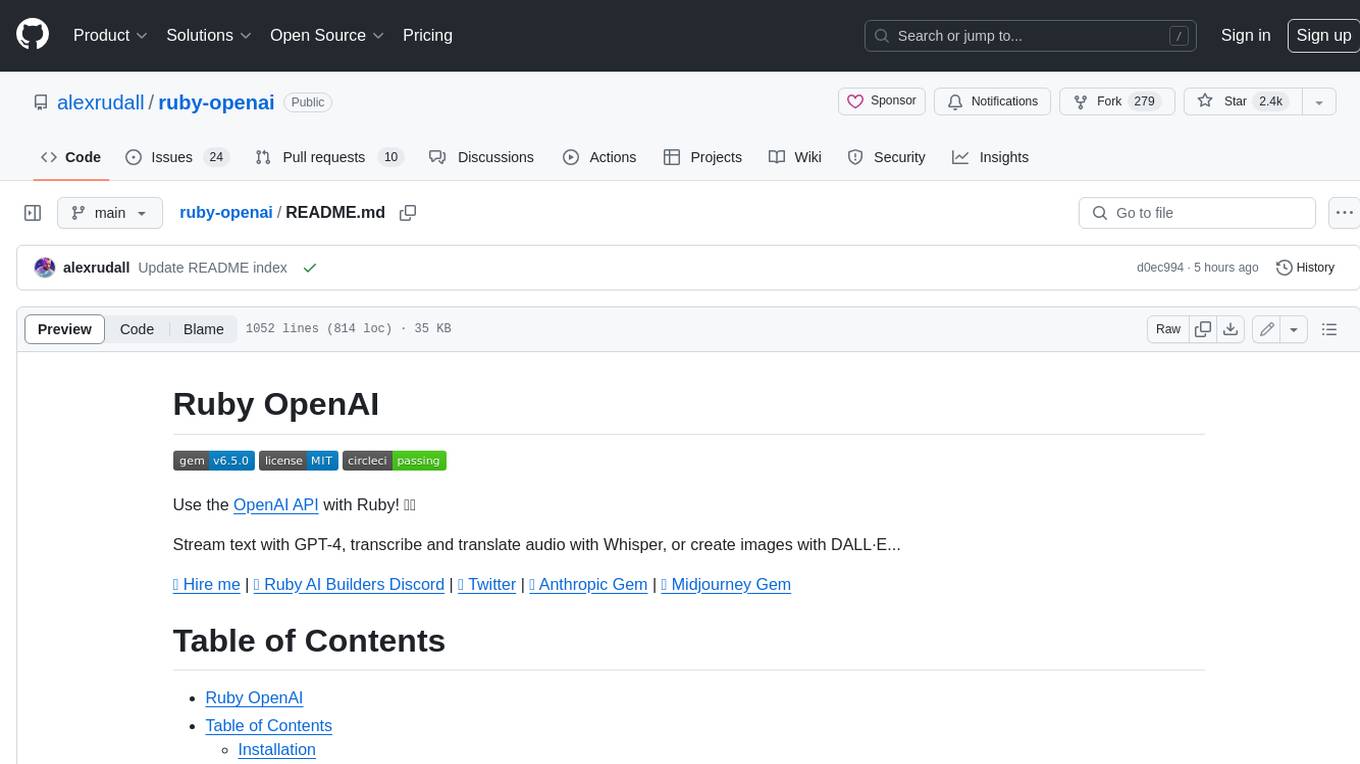
ruby-openai
Use the OpenAI API with Ruby! 🤖🩵 Stream text with GPT-4, transcribe and translate audio with Whisper, or create images with DALL·E... Hire me | 🎮 Ruby AI Builders Discord | 🐦 Twitter | 🧠 Anthropic Gem | 🚂 Midjourney Gem ## Table of Contents * Ruby OpenAI * Table of Contents * Installation * Bundler * Gem install * Usage * Quickstart * With Config * Custom timeout or base URI * Extra Headers per Client * Logging * Errors * Faraday middleware * Azure * Ollama * Counting Tokens * Models * Examples * Chat * Streaming Chat * Vision * JSON Mode * Functions * Edits * Embeddings * Batches * Files * Finetunes * Assistants * Threads and Messages * Runs * Runs involving function tools * Image Generation * DALL·E 2 * DALL·E 3 * Image Edit * Image Variations * Moderations * Whisper * Translate * Transcribe * Speech * Errors * Development * Release * Contributing * License * Code of Conduct
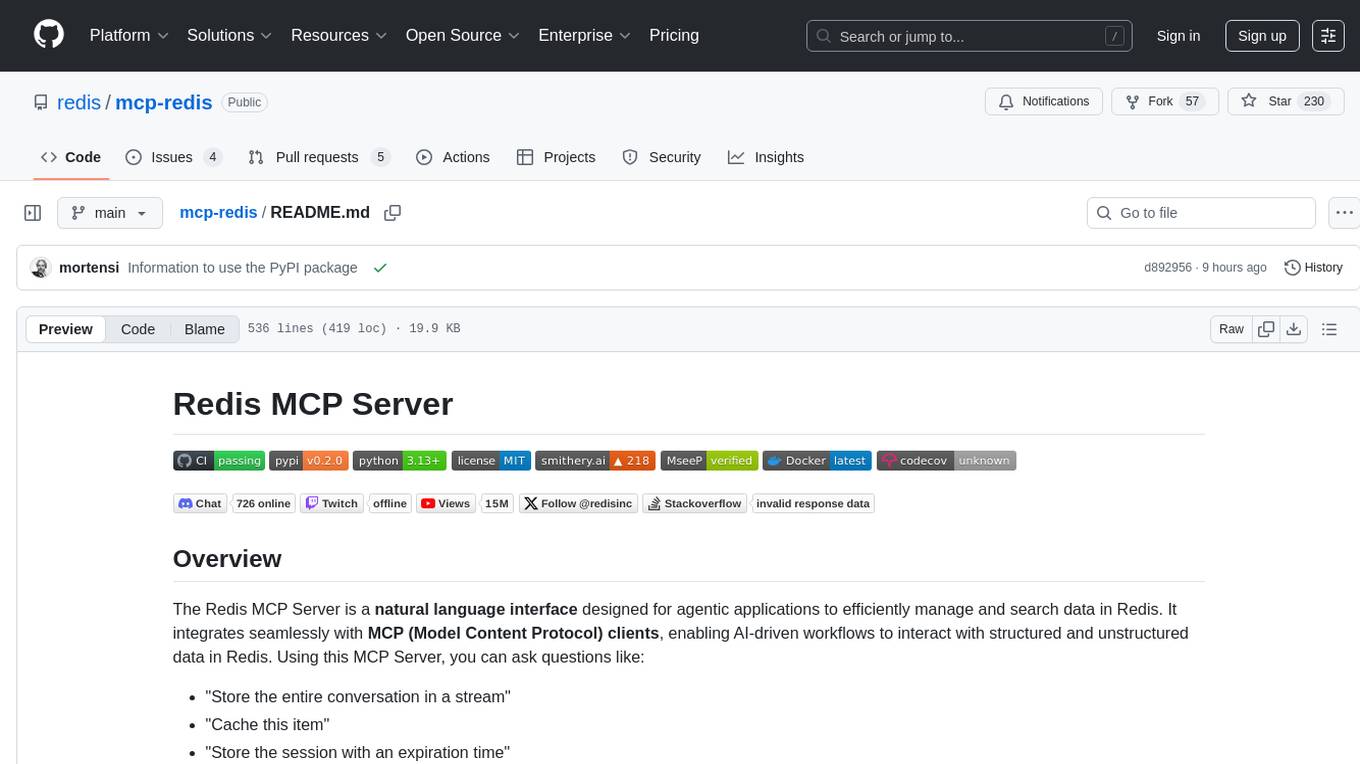
mcp-redis
The Redis MCP Server is a natural language interface designed for agentic applications to efficiently manage and search data in Redis. It integrates seamlessly with MCP (Model Content Protocol) clients, enabling AI-driven workflows to interact with structured and unstructured data in Redis. The server supports natural language queries, seamless MCP integration, full Redis support for various data types, search and filtering capabilities, scalability, and lightweight design. It provides tools for managing data stored in Redis, such as string, hash, list, set, sorted set, pub/sub, streams, JSON, query engine, and server management. Installation can be done from PyPI or GitHub, with options for testing, development, and Docker deployment. Configuration can be via command line arguments or environment variables. Integrations include OpenAI Agents SDK, Augment, Claude Desktop, and VS Code with GitHub Copilot. Use cases include AI assistants, chatbots, data search & analytics, and event processing. Contributions are welcome under the MIT License.
aiavatarkit
AIAvatarKit is a tool for building AI-based conversational avatars quickly. It supports various platforms like VRChat and cluster, along with real-world devices. The tool is extensible, allowing unlimited capabilities based on user needs. It requires VOICEVOX API, Google or Azure Speech Services API keys, and Python 3.10. Users can start conversations out of the box and enjoy seamless interactions with the avatars.
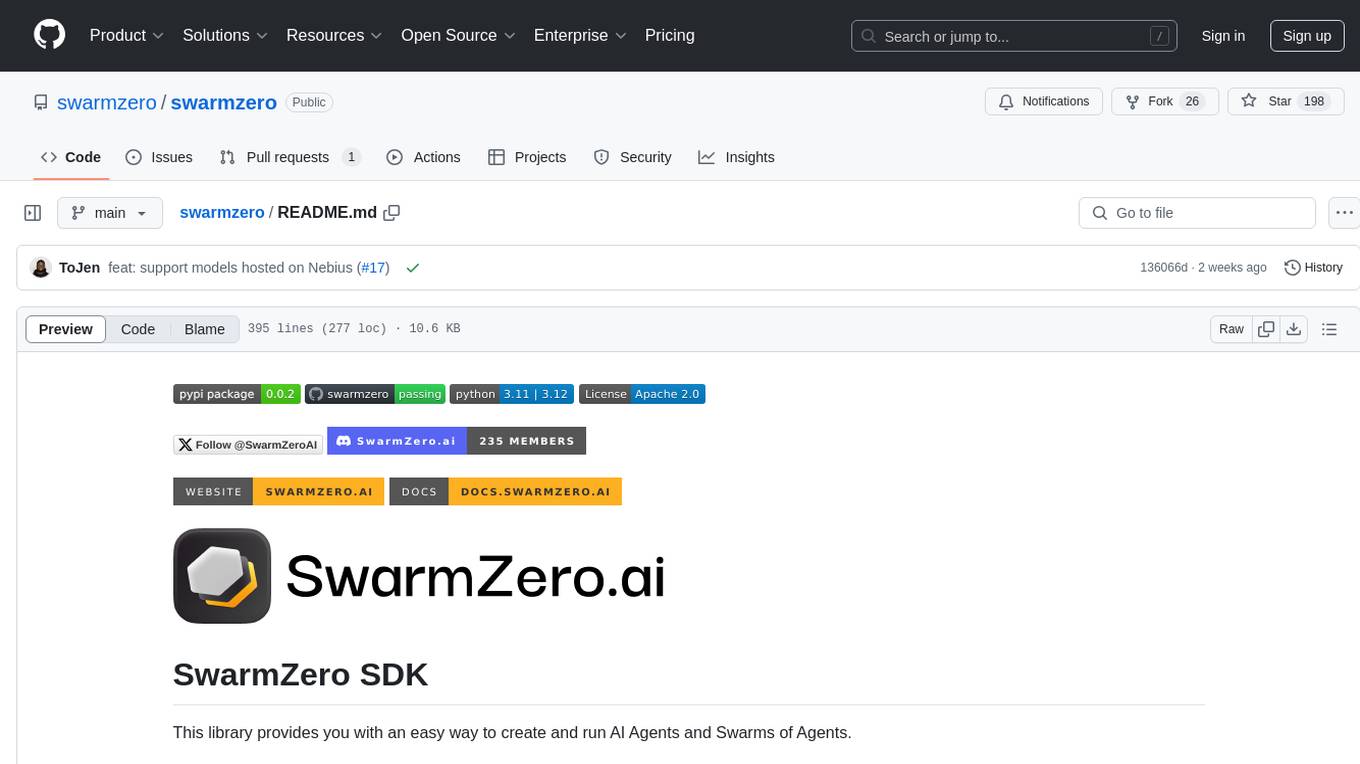
swarmzero
SwarmZero SDK is a library that simplifies the creation and execution of AI Agents and Swarms of Agents. It supports various LLM Providers such as OpenAI, Azure OpenAI, Anthropic, MistralAI, Gemini, Nebius, and Ollama. Users can easily install the library using pip or poetry, set up the environment and configuration, create and run Agents, collaborate with Swarms, add tools for complex tasks, and utilize retriever tools for semantic information retrieval. Sample prompts are provided to help users explore the capabilities of the agents and swarms. The SDK also includes detailed examples and documentation for reference.
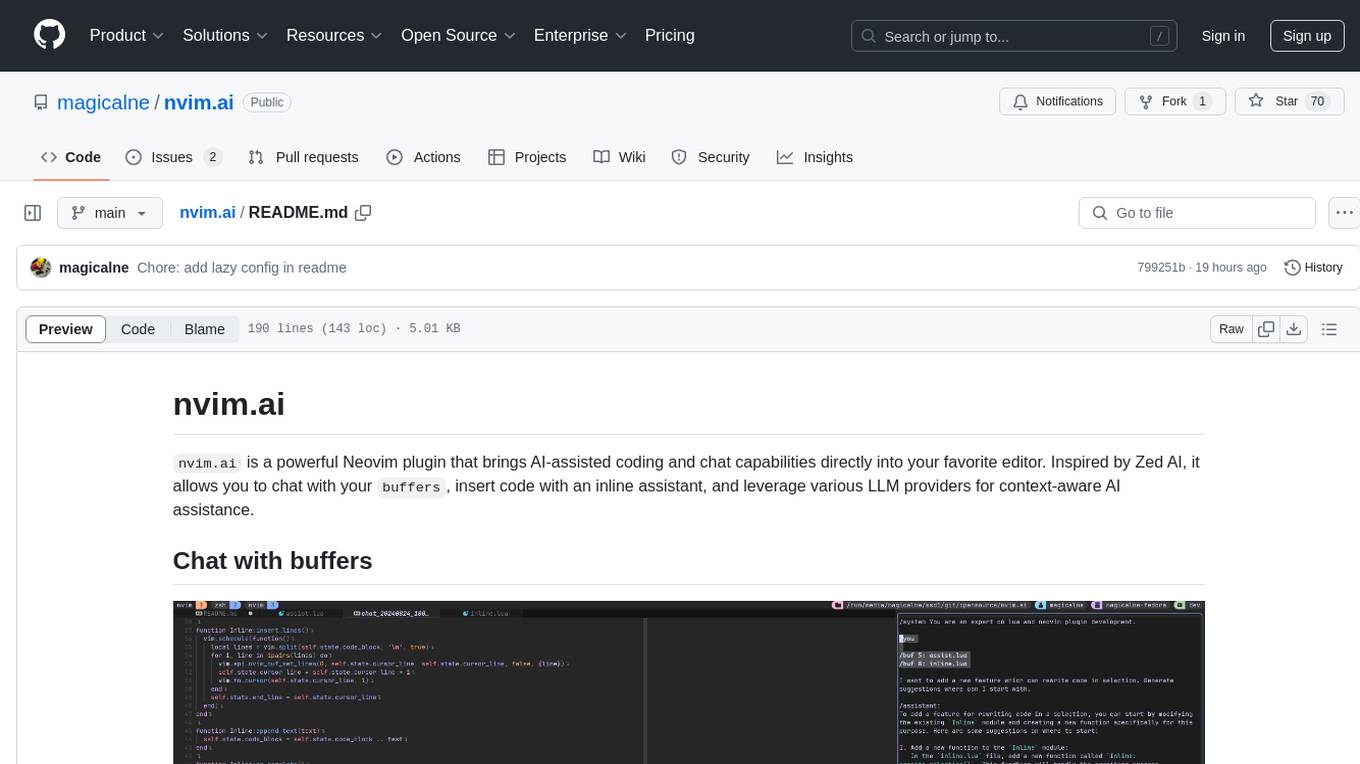
nvim.ai
nvim.ai is a powerful Neovim plugin that enables AI-assisted coding and chat capabilities within the editor. Users can chat with buffers, insert code with an inline assistant, and utilize various LLM providers for context-aware AI assistance. The plugin supports features like interacting with AI about code and documents, receiving relevant help based on current work, code insertion, code rewriting (Work in Progress), and integration with multiple LLM providers. Users can configure the plugin, add API keys to dotfiles, and integrate with nvim-cmp for command autocompletion. Keymaps are available for chat and inline assist functionalities. The chat dialog allows parsing content with keywords and supports roles like /system, /you, and /assistant. Context-aware assistance can be accessed through inline assist by inserting code blocks anywhere in the file.
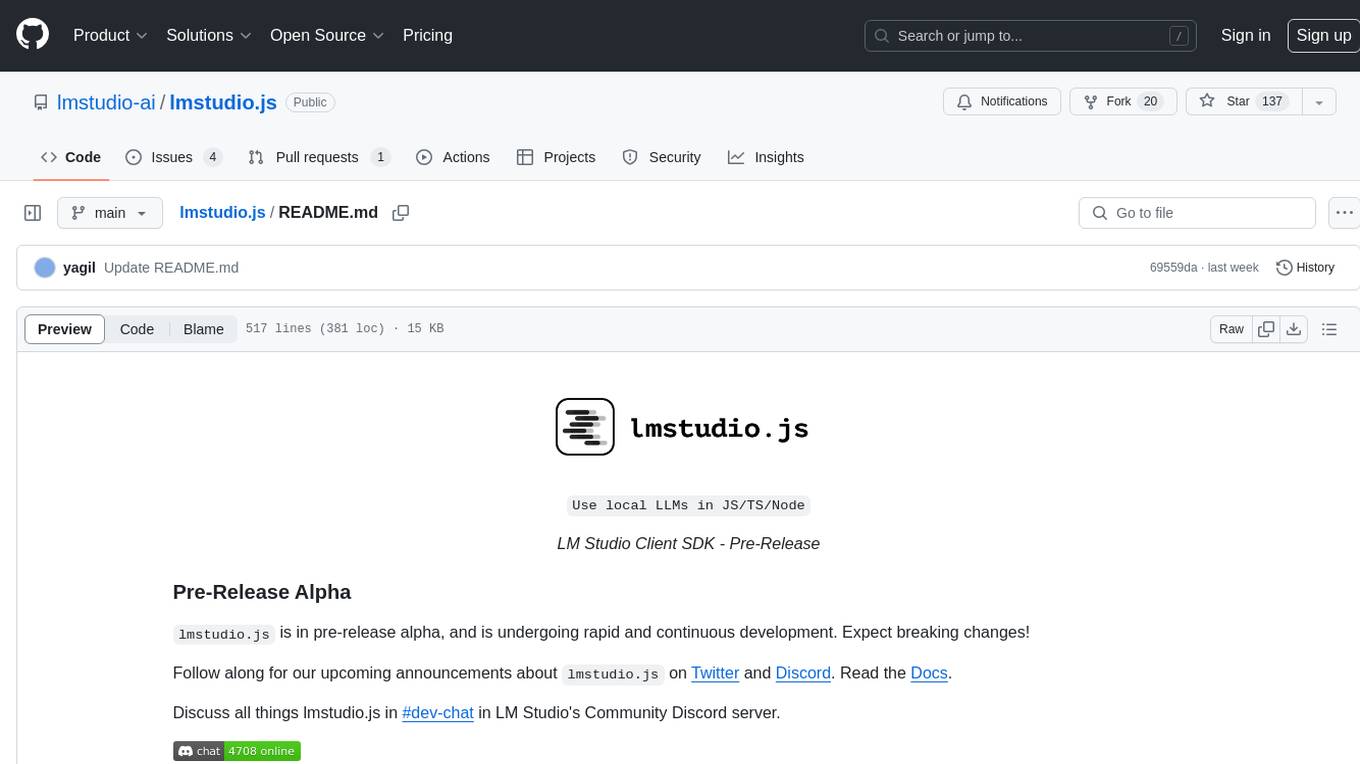
lmstudio.js
lmstudio.js is a pre-release alpha client SDK for LM Studio, allowing users to use local LLMs in JS/TS/Node. It is currently undergoing rapid development with breaking changes expected. Users can follow LM Studio's announcements on Twitter and Discord. The SDK provides API usage for loading models, predicting text, setting up the local LLM server, and more. It supports features like custom loading progress tracking, model unloading, structured output prediction, and cancellation of predictions. Users can interact with LM Studio through the CLI tool 'lms' and perform tasks like text completion, conversation, and getting prediction statistics.
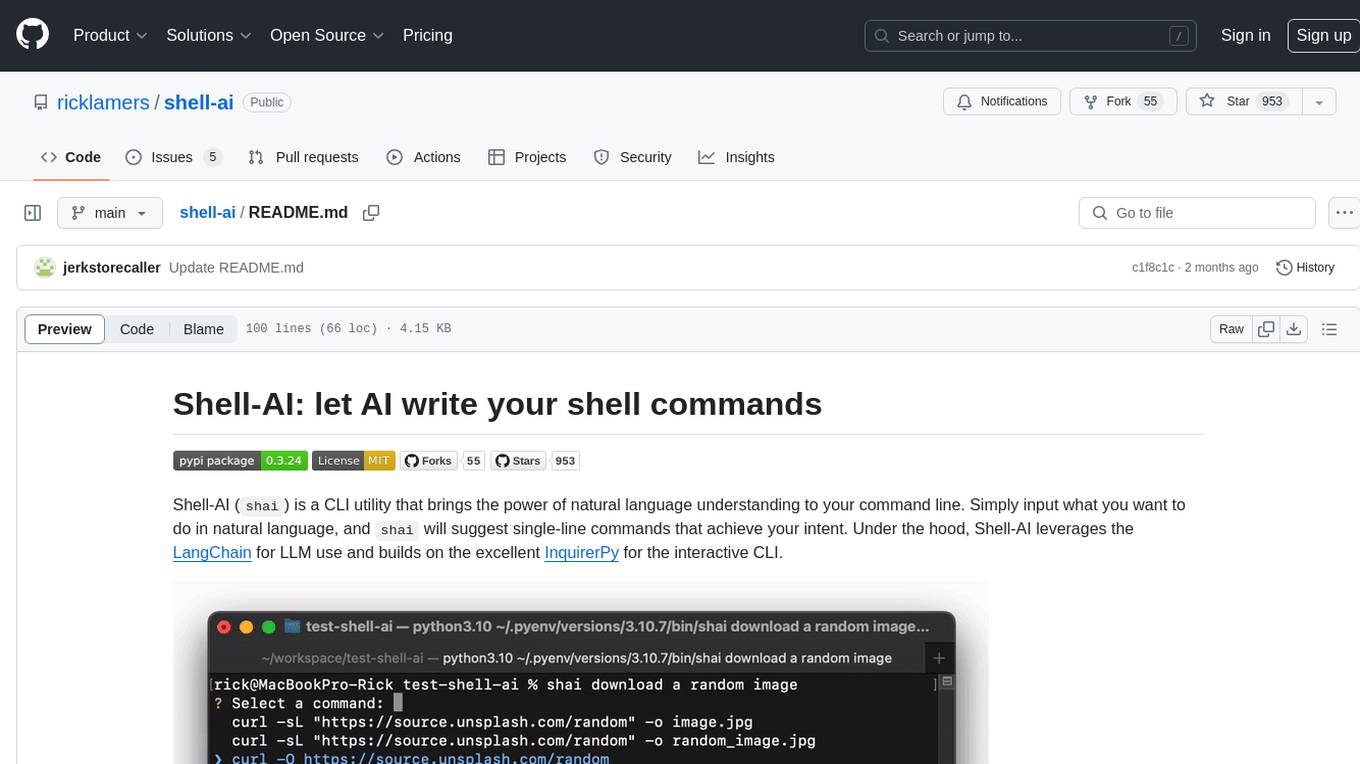
shell-ai
Shell-AI (`shai`) is a CLI utility that enables users to input commands in natural language and receive single-line command suggestions. It leverages natural language understanding and interactive CLI tools to enhance command line interactions. Users can describe tasks in plain English and receive corresponding command suggestions, making it easier to execute commands efficiently. Shell-AI supports cross-platform usage and is compatible with Azure OpenAI deployments, offering a user-friendly and efficient way to interact with the command line.
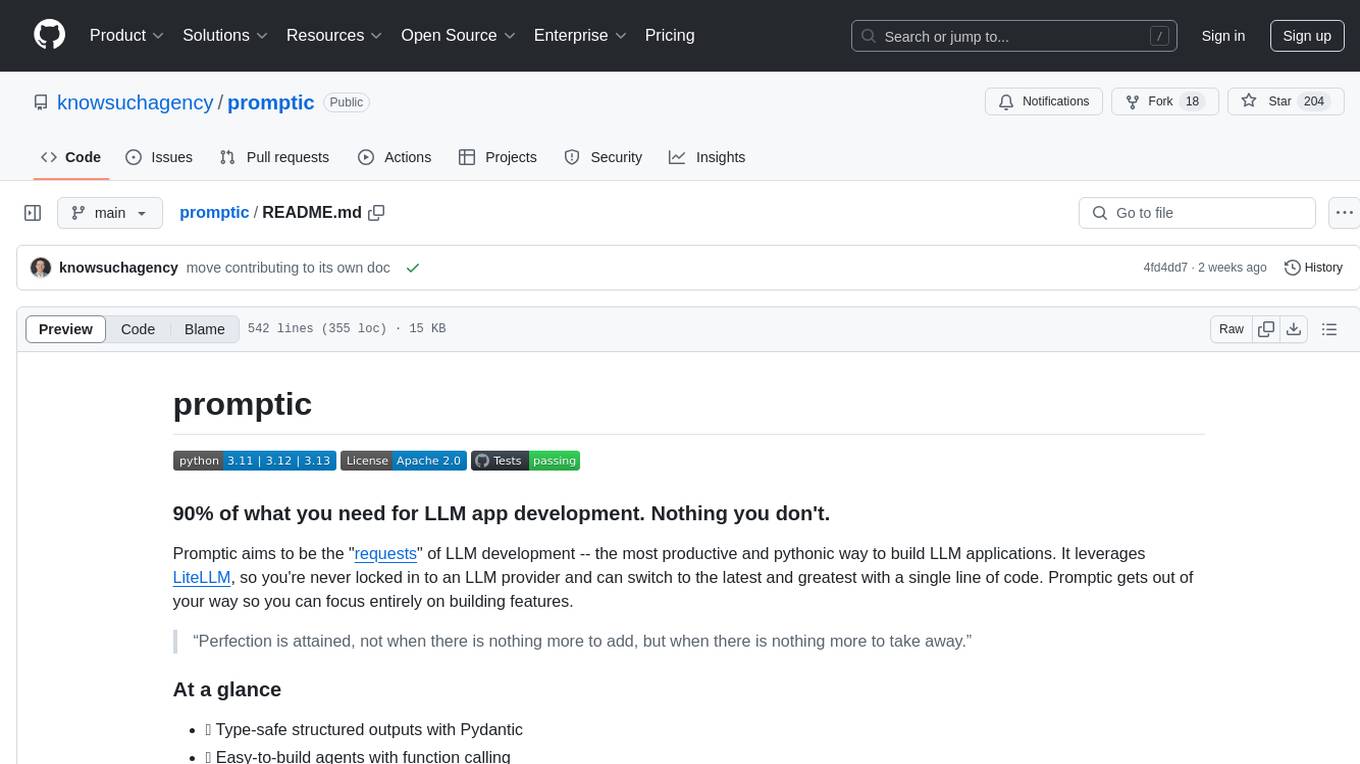
promptic
Promptic is a tool designed for LLM app development, providing a productive and pythonic way to build LLM applications. It leverages LiteLLM, allowing flexibility to switch LLM providers easily. Promptic focuses on building features by providing type-safe structured outputs, easy-to-build agents, streaming support, automatic prompt caching, and built-in conversation memory.
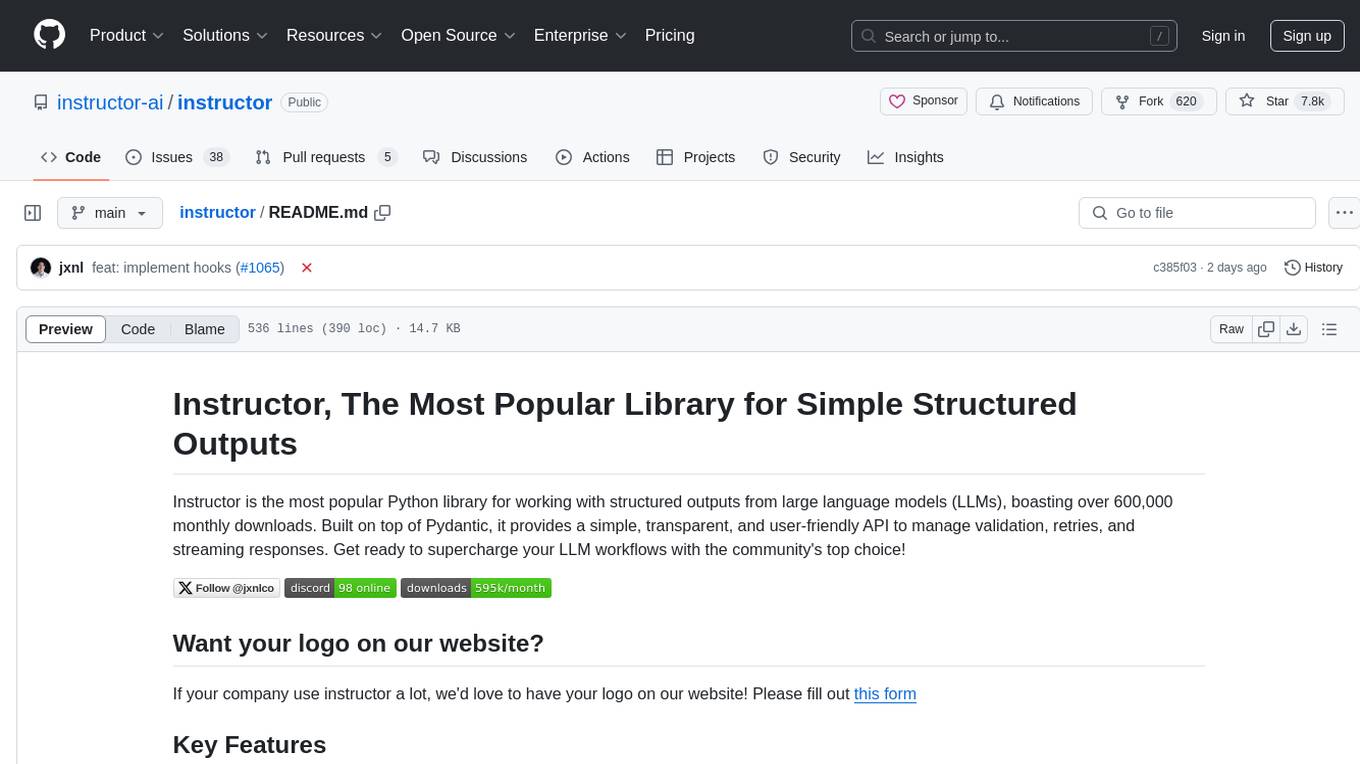
instructor
Instructor is a popular Python library for managing structured outputs from large language models (LLMs). It offers a user-friendly API for validation, retries, and streaming responses. With support for various LLM providers and multiple languages, Instructor simplifies working with LLM outputs. The library includes features like response models, retry management, validation, streaming support, and flexible backends. It also provides hooks for logging and monitoring LLM interactions, and supports integration with Anthropic, Cohere, Gemini, Litellm, and Google AI models. Instructor facilitates tasks such as extracting user data from natural language, creating fine-tuned models, managing uploaded files, and monitoring usage of OpenAI models.
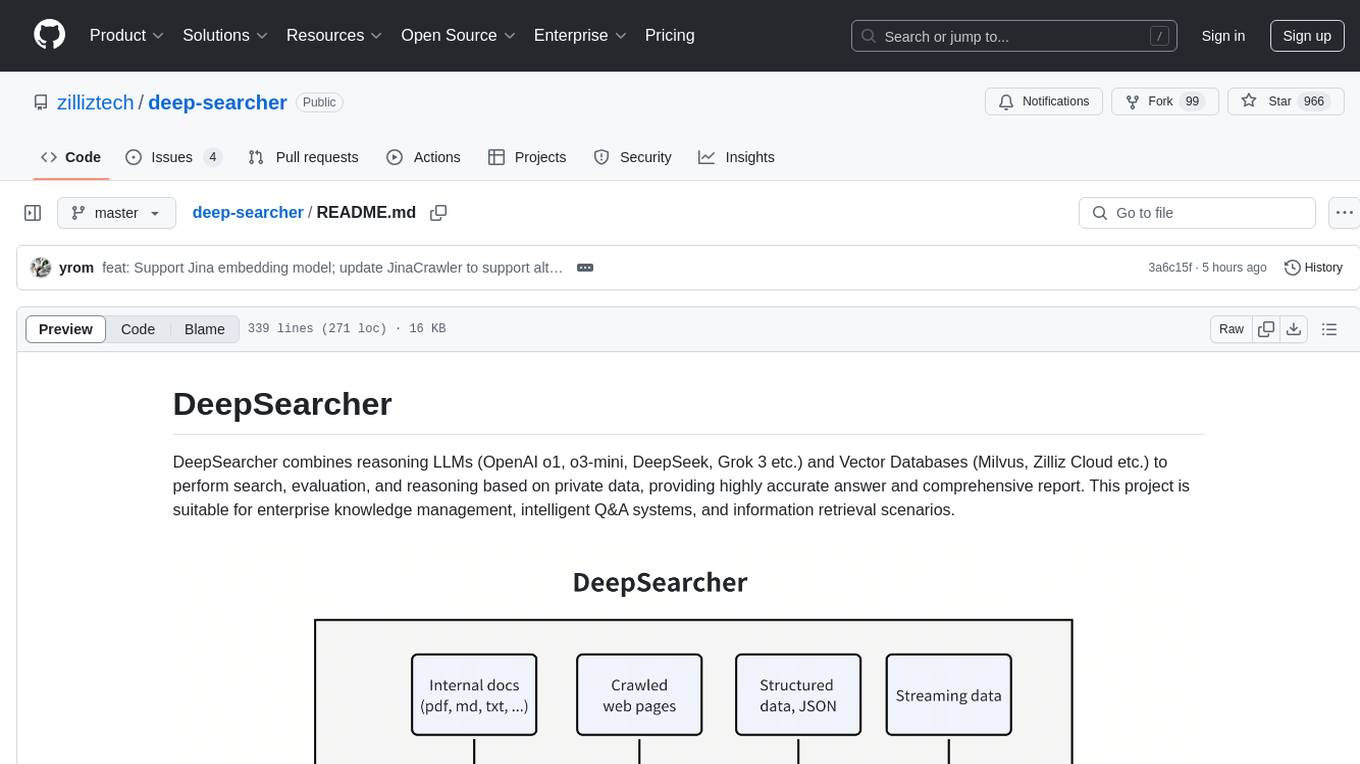
deep-searcher
DeepSearcher is a tool that combines reasoning LLMs and Vector Databases to perform search, evaluation, and reasoning based on private data. It is suitable for enterprise knowledge management, intelligent Q&A systems, and information retrieval scenarios. The tool maximizes the utilization of enterprise internal data while ensuring data security, supports multiple embedding models, and provides support for multiple LLMs for intelligent Q&A and content generation. It also includes features like private data search, vector database management, and document loading with web crawling capabilities under development.
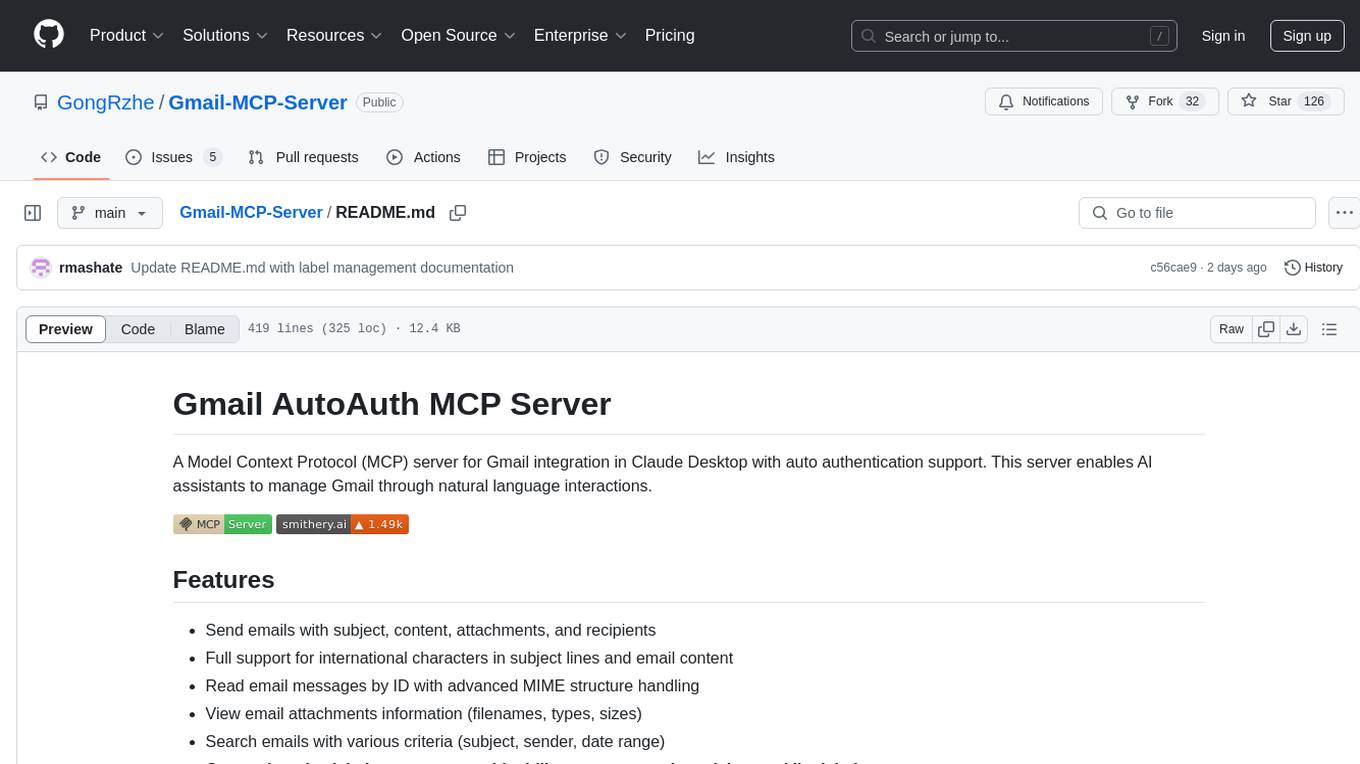
Gmail-MCP-Server
Gmail AutoAuth MCP Server is a Model Context Protocol (MCP) server designed for Gmail integration in Claude Desktop. It supports auto authentication and enables AI assistants to manage Gmail through natural language interactions. The server provides comprehensive features for sending emails, reading messages, managing labels, searching emails, and batch operations. It offers full support for international characters, email attachments, and Gmail API integration. Users can install and authenticate the server via Smithery or manually with Google Cloud Project credentials. The server supports both Desktop and Web application credentials, with global credential storage for convenience. It also includes Docker support and instructions for cloud server authentication.
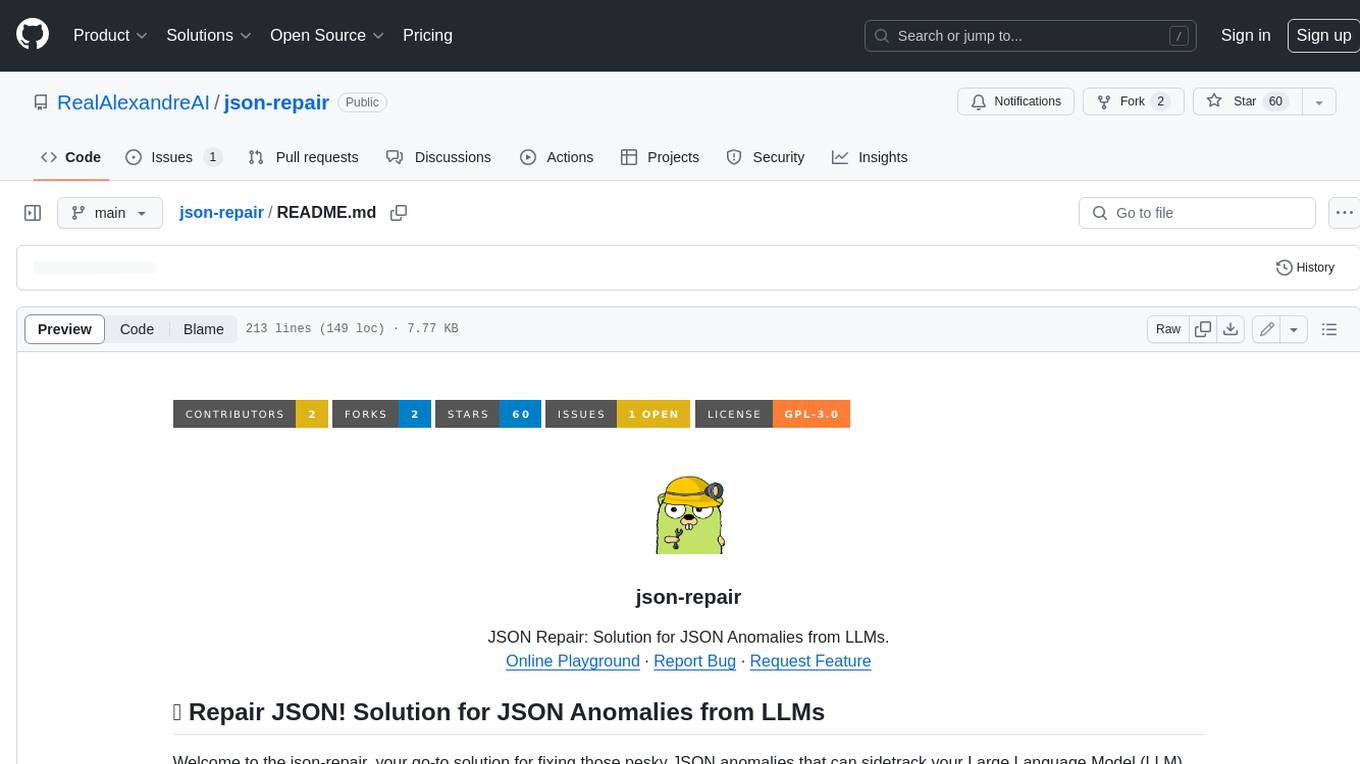
json-repair
JSON Repair is a toolkit designed to address JSON anomalies that can arise from Large Language Models (LLMs). It offers a comprehensive solution for repairing JSON strings, ensuring accuracy and reliability in your data processing. With its user-friendly interface and extensive capabilities, JSON Repair empowers developers to seamlessly integrate JSON repair into their workflows.
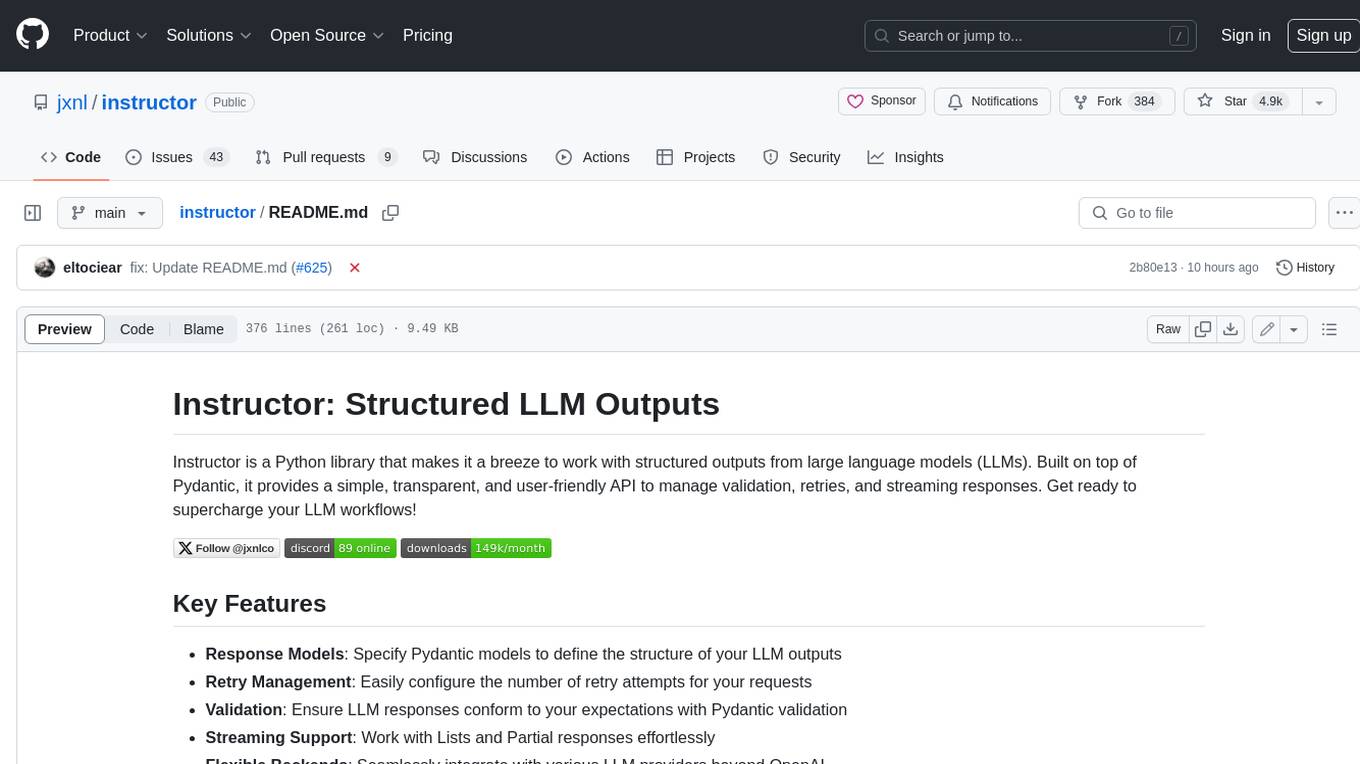
instructor
Instructor is a Python library that makes it a breeze to work with structured outputs from large language models (LLMs). Built on top of Pydantic, it provides a simple, transparent, and user-friendly API to manage validation, retries, and streaming responses. Get ready to supercharge your LLM workflows!
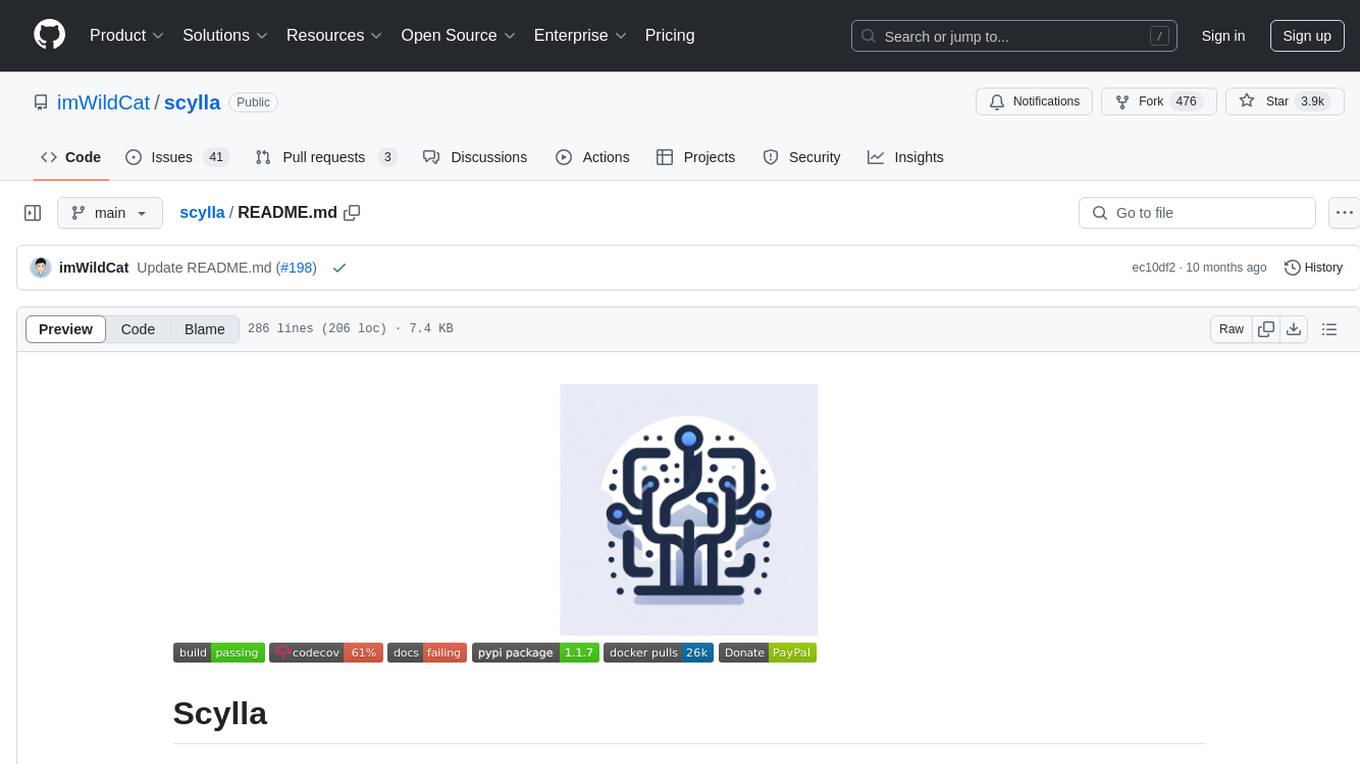
scylla
Scylla is an intelligent proxy pool tool designed for humanities, enabling users to extract content from the internet and build their own Large Language Models in the AI era. It features automatic proxy IP crawling and validation, an easy-to-use JSON API, a simple web-based user interface, HTTP forward proxy server, Scrapy and requests integration, and headless browser crawling. Users can start using Scylla with just one command, making it a versatile tool for various web scraping and content extraction tasks.
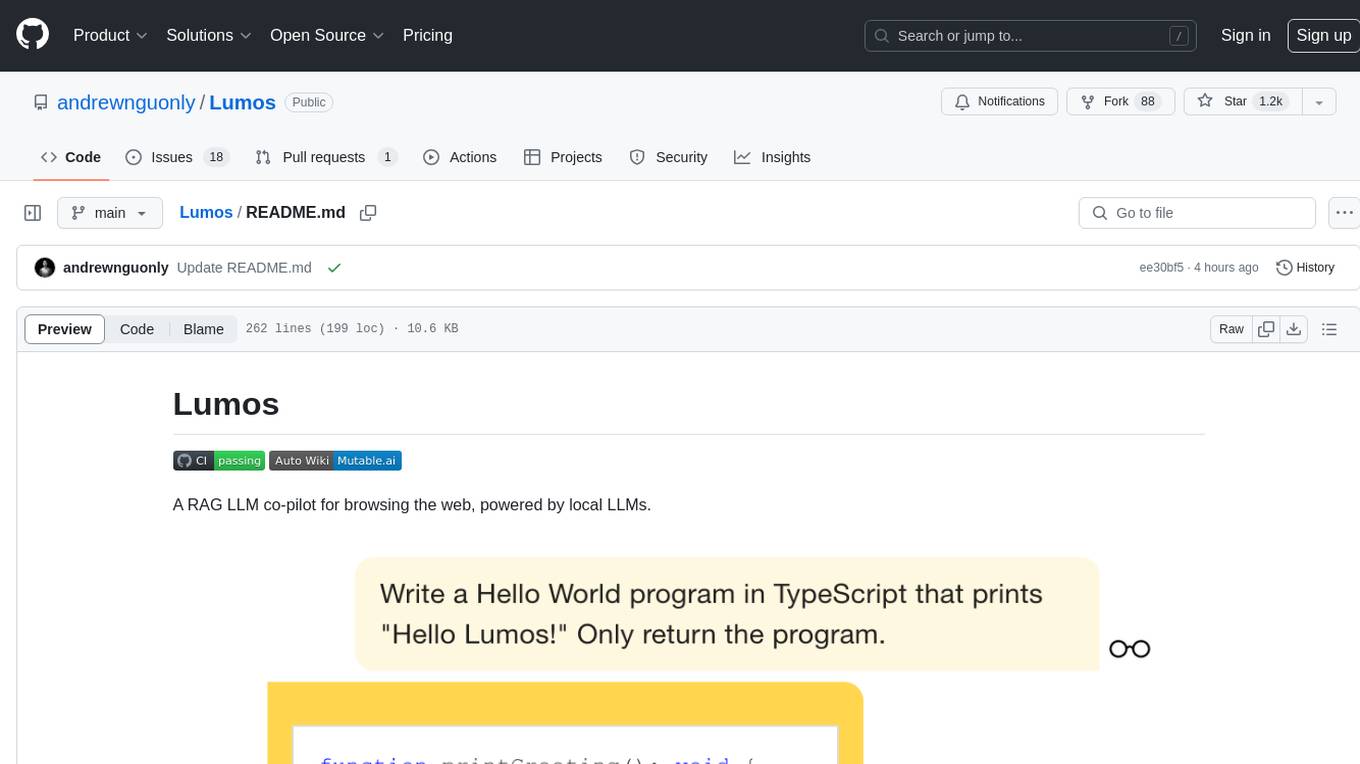
Lumos
Lumos is a Chrome extension powered by a local LLM co-pilot for browsing the web. It allows users to summarize long threads, news articles, and technical documentation. Users can ask questions about reviews and product pages. The tool requires a local Ollama server for LLM inference and embedding database. Lumos supports multimodal models and file attachments for processing text and image content. It also provides options to customize models, hosts, and content parsers. The extension can be easily accessed through keyboard shortcuts and offers tools for automatic invocation based on prompts.
For similar tasks

vim-ai
vim-ai is a plugin that adds Artificial Intelligence (AI) capabilities to Vim and Neovim. It allows users to generate code, edit text, and have interactive conversations with GPT models powered by OpenAI's API. The plugin uses OpenAI's API to generate responses, requiring users to set up an account and obtain an API key. It supports various commands for text generation, editing, and chat interactions, providing a seamless integration of AI features into the Vim text editor environment.
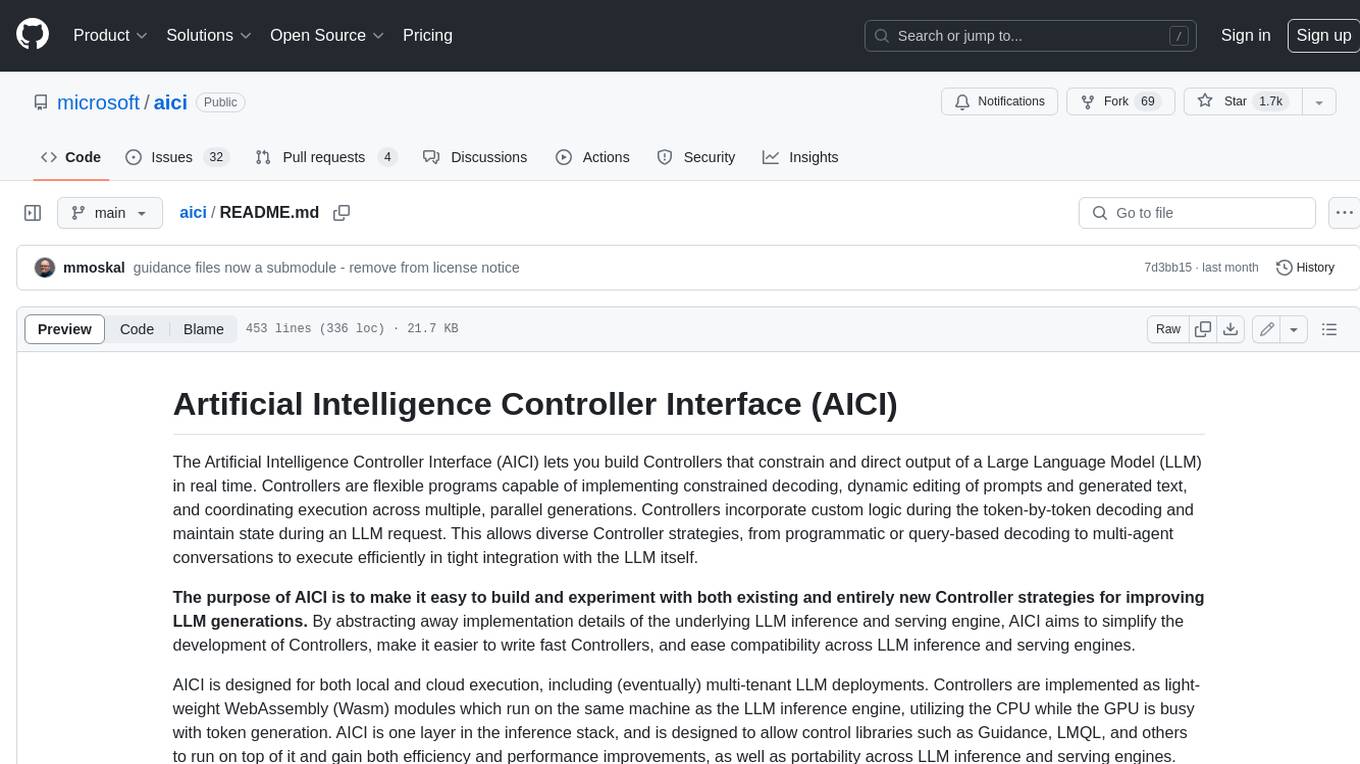
aici
The Artificial Intelligence Controller Interface (AICI) lets you build Controllers that constrain and direct output of a Large Language Model (LLM) in real time. Controllers are flexible programs capable of implementing constrained decoding, dynamic editing of prompts and generated text, and coordinating execution across multiple, parallel generations. Controllers incorporate custom logic during the token-by-token decoding and maintain state during an LLM request. This allows diverse Controller strategies, from programmatic or query-based decoding to multi-agent conversations to execute efficiently in tight integration with the LLM itself.
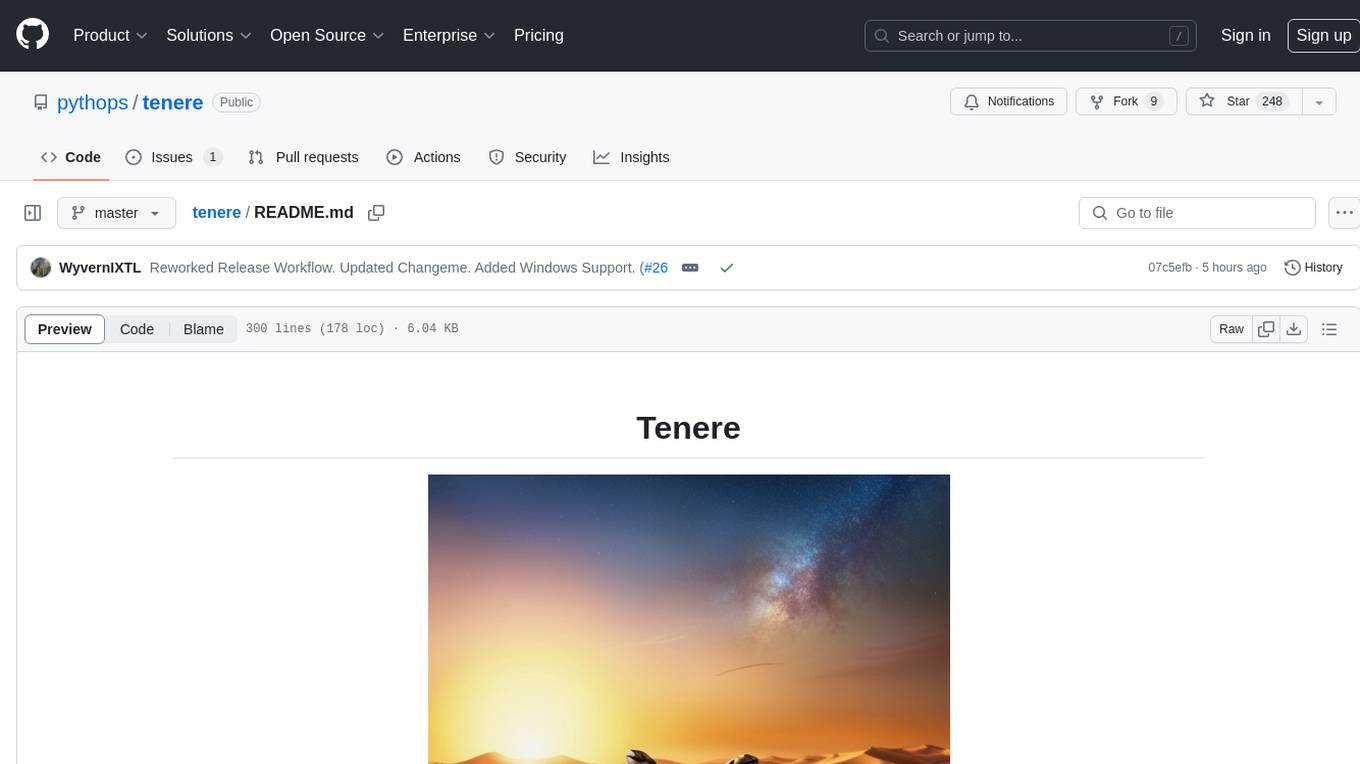
tenere
Tenere is a TUI interface for Language Model Libraries (LLMs) written in Rust. It provides syntax highlighting, chat history, saving chats to files, Vim keybindings, copying text from/to clipboard, and supports multiple backends. Users can configure Tenere using a TOML configuration file, set key bindings, and use different LLMs such as ChatGPT, llama.cpp, and ollama. Tenere offers default key bindings for global and prompt modes, with features like starting a new chat, saving chats, scrolling, showing chat history, and quitting the app. Users can interact with the prompt in different modes like Normal, Visual, and Insert, with various key bindings for navigation, editing, and text manipulation.
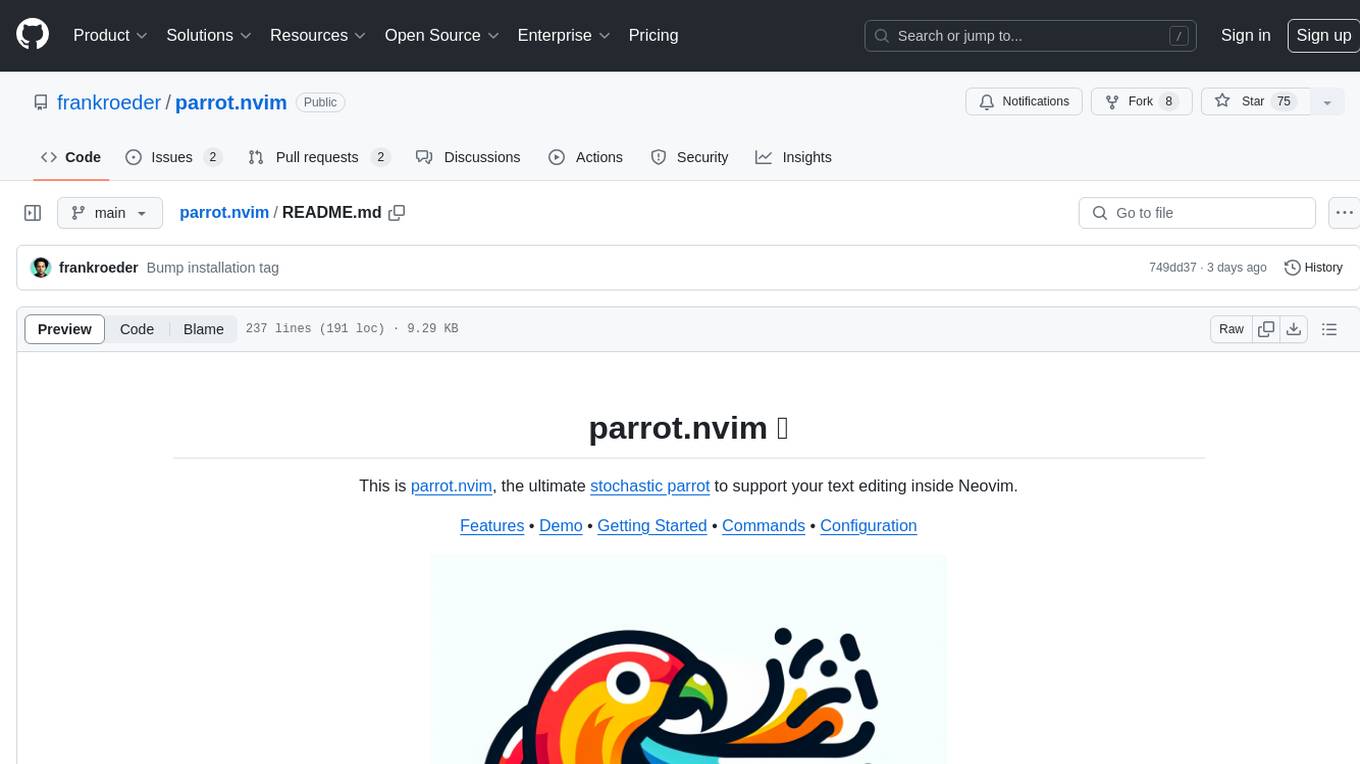
parrot.nvim
Parrot.nvim is a Neovim plugin that prioritizes a seamless out-of-the-box experience for text generation. It simplifies functionality and focuses solely on text generation, excluding integration of DALLE and Whisper. It supports persistent conversations as markdown files, custom hooks for inline text editing, multiple providers like Anthropic API, perplexity.ai API, OpenAI API, Mistral API, and local/offline serving via ollama. It allows custom agent definitions, flexible API credential support, and repository-specific instructions with a `.parrot.md` file. It does not have autocompletion or hidden requests in the background to analyze files.
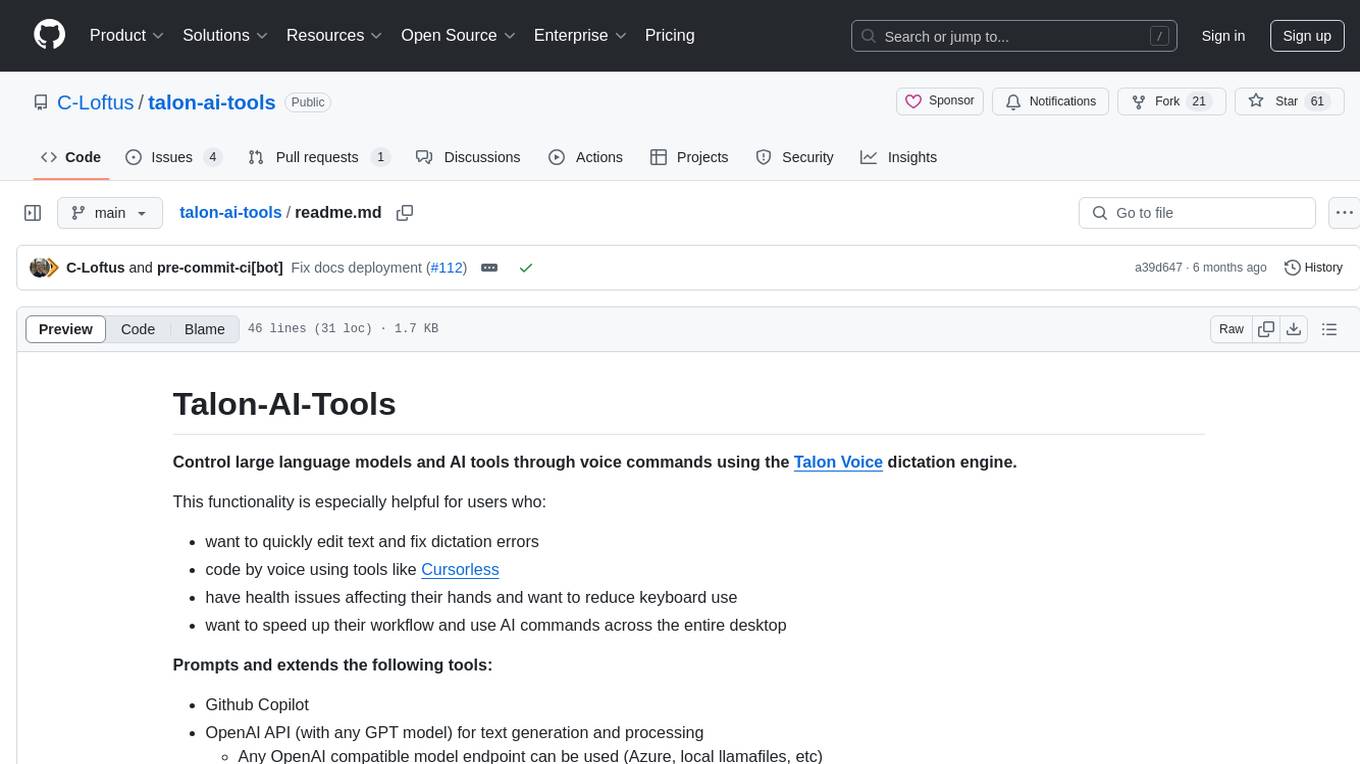
talon-ai-tools
Control large language models and AI tools through voice commands using the Talon Voice dictation engine. This tool is designed to help users quickly edit text, code by voice, reduce keyboard use for those with health issues, and speed up workflow by using AI commands across the desktop. It prompts and extends tools like Github Copilot and OpenAI API for text and image generation. Users can set up the tool by downloading the repo, obtaining an OpenAI API key, and customizing the endpoint URL for preferred models. The tool can be used without an OpenAI key and can be exclusively used with Copilot for those not needing LLM integration.
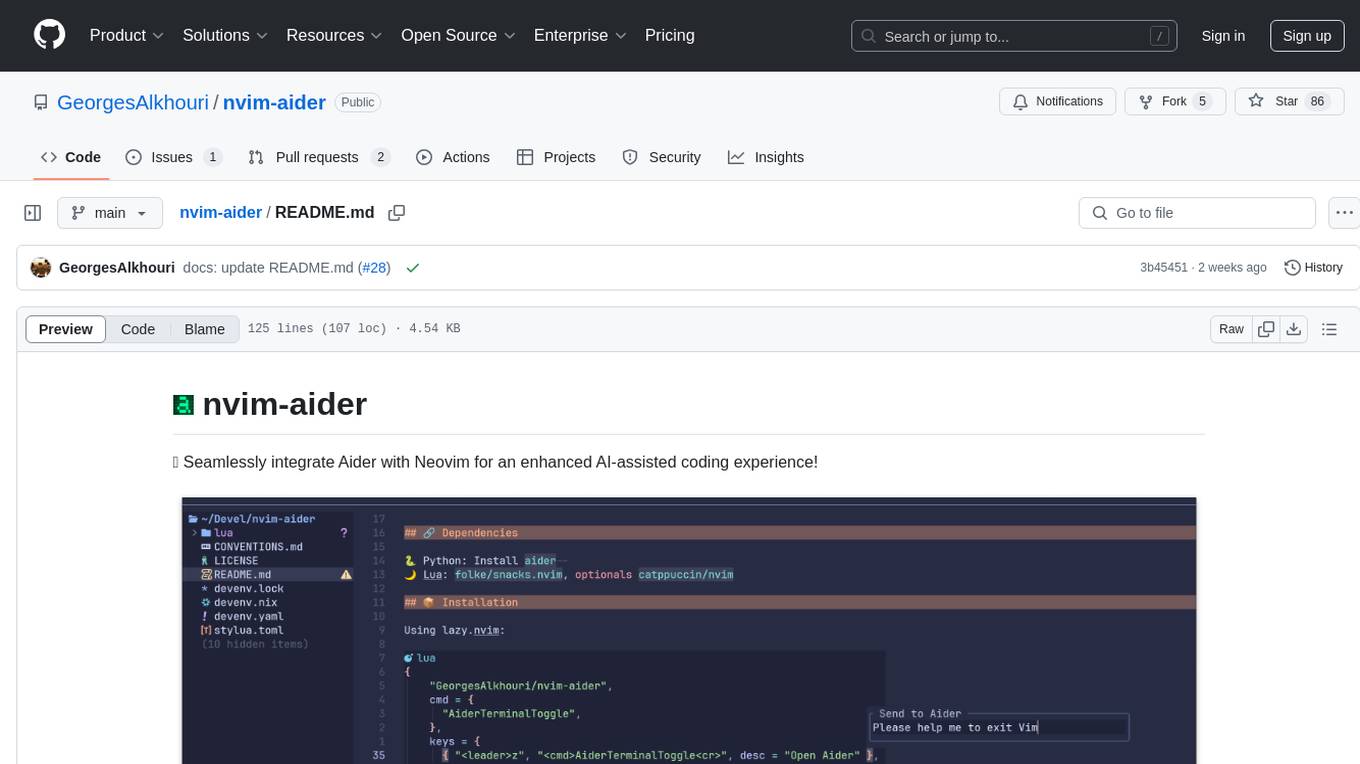
nvim-aider
Nvim-aider is a plugin for Neovim that provides additional functionality and key mappings to enhance the user's editing experience. It offers features such as code navigation, quick access to commonly used commands, and improved text manipulation tools. With Nvim-aider, users can streamline their workflow and increase productivity while working with Neovim.

ai-guide
This guide is dedicated to Large Language Models (LLMs) that you can run on your home computer. It assumes your PC is a lower-end, non-gaming setup.

onnxruntime-genai
ONNX Runtime Generative AI is a library that provides the generative AI loop for ONNX models, including inference with ONNX Runtime, logits processing, search and sampling, and KV cache management. Users can call a high level `generate()` method, or run each iteration of the model in a loop. It supports greedy/beam search and TopP, TopK sampling to generate token sequences, has built in logits processing like repetition penalties, and allows for easy custom scoring.
For similar jobs

sweep
Sweep is an AI junior developer that turns bugs and feature requests into code changes. It automatically handles developer experience improvements like adding type hints and improving test coverage.

teams-ai
The Teams AI Library is a software development kit (SDK) that helps developers create bots that can interact with Teams and Microsoft 365 applications. It is built on top of the Bot Framework SDK and simplifies the process of developing bots that interact with Teams' artificial intelligence capabilities. The SDK is available for JavaScript/TypeScript, .NET, and Python.

ai-guide
This guide is dedicated to Large Language Models (LLMs) that you can run on your home computer. It assumes your PC is a lower-end, non-gaming setup.

classifai
Supercharge WordPress Content Workflows and Engagement with Artificial Intelligence. Tap into leading cloud-based services like OpenAI, Microsoft Azure AI, Google Gemini and IBM Watson to augment your WordPress-powered websites. Publish content faster while improving SEO performance and increasing audience engagement. ClassifAI integrates Artificial Intelligence and Machine Learning technologies to lighten your workload and eliminate tedious tasks, giving you more time to create original content that matters.

chatbot-ui
Chatbot UI is an open-source AI chat app that allows users to create and deploy their own AI chatbots. It is easy to use and can be customized to fit any need. Chatbot UI is perfect for businesses, developers, and anyone who wants to create a chatbot.

BricksLLM
BricksLLM is a cloud native AI gateway written in Go. Currently, it provides native support for OpenAI, Anthropic, Azure OpenAI and vLLM. BricksLLM aims to provide enterprise level infrastructure that can power any LLM production use cases. Here are some use cases for BricksLLM: * Set LLM usage limits for users on different pricing tiers * Track LLM usage on a per user and per organization basis * Block or redact requests containing PIIs * Improve LLM reliability with failovers, retries and caching * Distribute API keys with rate limits and cost limits for internal development/production use cases * Distribute API keys with rate limits and cost limits for students

uAgents
uAgents is a Python library developed by Fetch.ai that allows for the creation of autonomous AI agents. These agents can perform various tasks on a schedule or take action on various events. uAgents are easy to create and manage, and they are connected to a fast-growing network of other uAgents. They are also secure, with cryptographically secured messages and wallets.

griptape
Griptape is a modular Python framework for building AI-powered applications that securely connect to your enterprise data and APIs. It offers developers the ability to maintain control and flexibility at every step. Griptape's core components include Structures (Agents, Pipelines, and Workflows), Tasks, Tools, Memory (Conversation Memory, Task Memory, and Meta Memory), Drivers (Prompt and Embedding Drivers, Vector Store Drivers, Image Generation Drivers, Image Query Drivers, SQL Drivers, Web Scraper Drivers, and Conversation Memory Drivers), Engines (Query Engines, Extraction Engines, Summary Engines, Image Generation Engines, and Image Query Engines), and additional components (Rulesets, Loaders, Artifacts, Chunkers, and Tokenizers). Griptape enables developers to create AI-powered applications with ease and efficiency.
